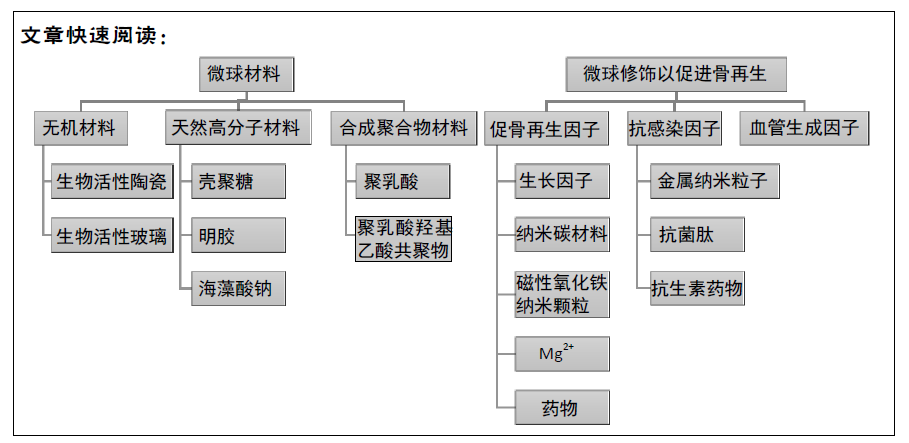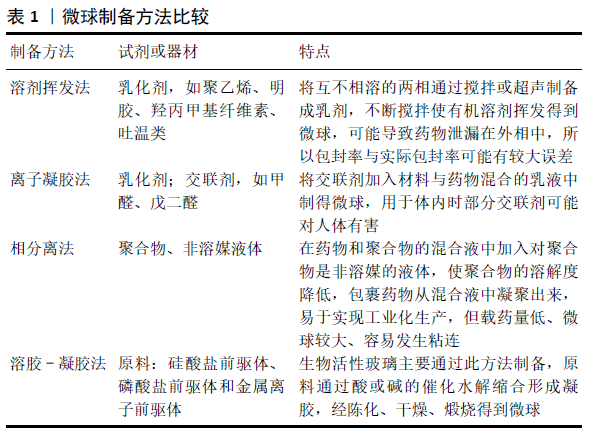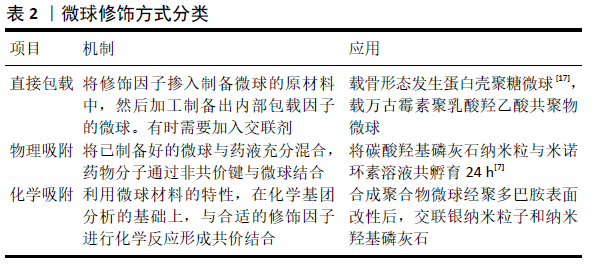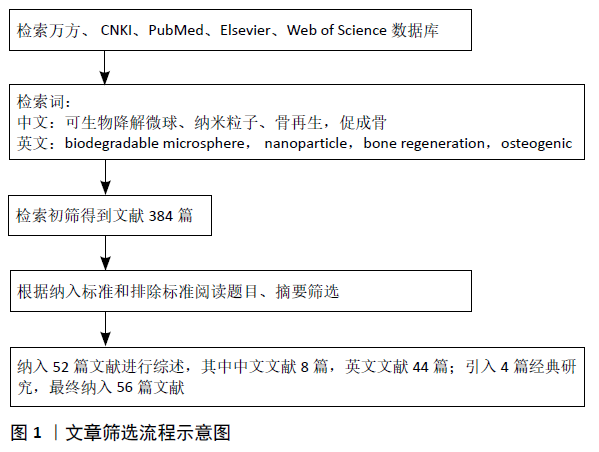[1] WANG W, YEUNG K. Bone grafts and biomaterials substitutes for bone defect repair: A review. Bioact Mater. 2017;2(4):224-247.
[2] BALDWIN P, LI D, AUSTON D, et al. Autograft, Allograft, and Bone Graft Substitutes: Clinical Evidence and Indications for Use in the Setting of Orthopaedic Trauma Surgery. J Orthop Trauma. 2019;33(4):203-213.
[3] 李晏乐,岳肖华,聂真,等.生物可吸收材料特点及在骨科中的应用[J].中国组织工程研究,2021,25(12):2612-2617.
[4] HOSSAIN KMZ, PATEL U, AHMED I. Development of microspheres for biomedical applications: a review. Prog Biomater. 2015;4(1):1-19.
[5] 卢静一,杨军星,王雷.缓释载药微球在慢性牙周炎中的应用研究进展[J].现代口腔医学杂志,2018,32(3):176-180.
[6] LIN K, XIA L, GAN J, et al. Tailoring the nanostructured surfaces of hydroxyapatite bioceramics to promote protein adsorption, osteoblast growth, and osteogenic differentiation. ACS Appl Mater Interfaces. 2013;5(16):8008-8017.
[7] LEITE AJ, CARIDADE SG, MANO JF. Synthesis and characterization of bioactive biodegradable chitosan composite spheres with shape memory capability. J Non Cryst Solids. 2016;432:158-166.
[8] 姚凯,何星.无定型磷酸钙微球的制备及在骨修复领域的应用[J].广东化工,2019,46(9):147-148.
[9] HENCH LL, SPLINTER RJ, ALLEN WC, et al. Bonding mechanisms at the interface of ceramic prosthetic materials. J Biomed Mater Res. 1971; 5(6):117-141.
[10] BAINO F, FIORILLI S, VITALE-BROVARONE C. Composite Biomaterials Based on Sol-Gel Mesoporous Silicate Glasses: A Review. Bioengineering (Basel). 2017;4(1):15.
[11] 陈雪颖.新型放射状介孔生物活性玻璃的制备及其作为药物载体的研究[D].广州:华南理工大学,2019.
[12] NASKAR S, SHARMA S, KUOTSU K. Chitosan-based nanoparticles: An overview of biomedical applications and its preparation. J Drug Deliv Sci Technol. 2019;49:66-81.
[13] XIA Y, WEI W, XIA H, et al. Effect of recombinant human bone morphogenetic protein delivered by chitosan microspheres on ectopic osteogenesis in rats. Exp Ther Med. 2019;17(5):3891-3898.
[14] AHMED T, ALJAEID B. Preparation, characterization, and potential application of chitosan, chitosan derivatives, and chitosan metal nanoparticles in pharmaceutical drug delivery. Drug Des Dev Ther. 2016;10:483-507.
[15] ANNAMALAI R, TURNER P, CARSON W, et al. Harnessing macrophage-mediated degradation of gelatin microspheres for spatiotemporal control of BMP2 release. Biomaterials. 2018;161:216-227.
[16] CALASANS-MAIA MD, BARBOZA JUNIOR CA, SORIANO-SOUZA CA, et al. Microspheres of alginate encapsulated minocycline-loaded nanocrystalline carbonated hydroxyapatite: therapeutic potential and effects on bone regeneration. Int J Nanomedicine. 2019;14:4559-4571.
[17] ZHAO Y, LIANG H, ZHANG S, et al.Effects of Magnesium Oxide (MgO) Shapes on In Vitro and In Vivo Degradation Behaviors of PLA/MgO Composites in Long Term. Polymers. 2020;12(5):1074.
[18] HU X, HE J, YONG X, et al. Biodegradable poly (lactic acid-co-trimethylene carbonate)/chitosan microsphere scaffold with shape-memory effect for bone tissue engineering. Colloids Surf B Biointerfaces. 2020;195:111218.
[19] YANG YY, CHUNG TS, NG NP. Morphology, drug distribution, and in vitro release profiles of biodegradable polymeric microspheres containing protein fabricated by double-emulsionsolvent extraction/evaporation method. Biomaterials. 2001;22(3):231-241.
[20] SIEPMANN J, FAISANT N, AKIKI J, et al. Effect of the sizes of biodegradable microparticles of drug release: Experiment and theory. J Control Release. 2004;96(1):123-134.
[21] BLANCOPRÍETO MJ, LEO E, DELIE F, et al. Study of the influence of several stabilizing agents on the entrapment and in vitro release of pBC 264 from poly(lactide-co-glycolide) microspheres prepared by a W/O/W solvent evaporation method. Pharm Res. 1996;13(7):1127-1129.
[22] ZHOU Z, YAO Q, LI L, et al. Antimicrobial Activity of 3D-Printed Poly(ε-Caprolactone) (PCL) Composite Scaffolds Presenting Vancomycin-Loaded Polylactic Acid-Glycolic Acid (PLGA) Microspheres. Med Sci Monit. 2018;24:6934-6945.
[23] CHEN H, WANG L, FU H, et al. Gadolinium Functionalized Carbon Dots for Fluorescence/Magnetic Resonance Dual-Modality Imaging of Mesenchymal Stem Cells. J Mater Chem B. 2016;4(46):7472-7480.
[24] XU B, JU Y, CUI Y, et al. Carbon nanotube array inducing osteogenic differentiation of human mesenchymal stem cells. Mater Sci Eng C. 2015;51:182-188.
[25] PARK J, KIM B, HAN J, et al. Graphene oxide flakes as a cellular adhesive: prevention of reactive oxygen species mediated death of implanted cells for cardiac repair. ACS Nano. 2015;9(5):4987-4999.
[26] SHAO D, LU M, XU D, et al.Carbon dots for tracking and promoting the osteogenic differentiation of mesenchymal stem cells. Biomater Sci. 2017;5(9):1820-1827.
[27] KHAJURIA D, KUMAR V, GIGI D, et al. Accelerated Bone Regeneration by Nitrogen-Doped Carbon Dots Functionalized with Hydroxyapatite Nanoparticles. ACS Appl Mater Interfaces. 2018;10(23):19373-19385.
[28] 代鹏展,刘新.BMP-2骨吸收作用的研究进展[J].中国实验诊断学, 2020,24(4):687-690.
[29] 陈良,王德飞,白涧飞,等.高浓度使用 BMP-2 的副作用及应对措施研究进展[J].中华老年口腔医学杂志,2018,16(6):358-361+377.
[30] WEI D, QIAO R, DAO J, et al. Soybean Lecithin-Mediated Nanoporous PLGA Microspheres with Highly Entrapped and Controlled Released BMP-2 as a Stem Cell Platform. Small. 2018;14(22):e1800063.
[31] LI Y, YE D, LI M, et al. Adaptive Materials Based on Iron Oxide Nanoparticles for Bone Regeneration. Chemphyschem. 2018;19(16):1965-1979.
[32] 校搏.顺磁性纳米纤维复合材料诱导骨缺损修复的动物实验研究[D].北京:北京协和医学院,2011.
[33] LU J, YANG F, KE Q, et al. Magnetic nanoparticles modified-porous scaffolds for bone regeneration and photothermal therapy against tumors. Nanomedicine. 2018;14(3):811-822.
[34] YUAN Z, WEI P, HUANG Y, et al. Injectable PLGA microspheres with tunable magnesium ion release for promoting bone regeneration. ACS Appl Mater. 2019;85:294-309.
[35] LIN Z, WU J, QIAO W, et al. Precisely controlled delivery of magnesium ions thru sponge-like monodisperse PLGA/nano-MgO-alginate core-shell microsphere device to enable in-situ bone regeneration. Biomaterials. 2018;174:1-16.
[36] ZHOU X, LIU P, NIE W, et al. Incorporation of dexamethasone-loaded mesoporous silica nanoparticles into mineralized porous biocomposite scaffolds for improving osteogenic activity. Int J Biol Macromol. 2020; 149:116-126.
[37] ZHANG J, MA S, LIU Z, et al. Guided bone regeneration with asymmetric collagen-chitosan membranes containing aspirin-loaded chitosan nanoparticles. Int J Nanomedicine. 2017;12:8855-8866.
[38] XUE Y, WU M, LIU Z, et al. In vitro and in vivo evaluation of chitosan scaffolds combined with simvastatin-loaded nanoparticles for guided bone regeneration. J Mater Sci Mater Med. 2019;30(4):47.
[39] SHOKROLAHI F, KHODABAKHSHI K, SHOKROLLAHI P, et al. Atorvastatin loaded PLGA microspheres: Preparation, HAp coating, drug release and effect on osteogenic differentiation of ADMSCs. Int J Pharm. 2019;565: 95-107.
[40] OSSIPOV D. Bisphosphonate-modified biomaterials for drug delivery and bone tissue engineering. Expert Opin Drug Deliv. 2015;12(9): 1443-1458.
[41] WEI P, YUAN Z, CAI Q, et al. Bioresorbable Microspheres with Surface-Loaded Nanosilver and Apatite as Dual-Functional Injectable Cell Carriers for Bone Regeneration. Macromol Rapid Commun. 2018; 39(20):e1800062.
[42] PORRELLI D, TRAVAN A, TURCO G, et al. Antibacterial-nanocomposite bone filler based on silver nanoparticles and polysaccharides. J Tissue Eng Regen Med. 2018;12(2):e747-e759.
[43] CHEN X, GAO C. Influences of size and surface coating of gold nanoparticles on inflammatory activation of macrophages.Colloids Surf B Biointerfaces. 2017;160:372-380.
[44] SUMBAYEV VV, YASINSKA IM, GARCIA CP, et al.Gold nanoparticles downregulate interleukin-1β-induced pro-inflammatory responses. Small. 2013;9(3):472-477.
[45] LIANG H, JIN C, MA L, et al. Accelerated Bone Regeneration by Gold-Nanoparticle-Loaded Mesoporous Silica through Stimulating Immunomodulatio. ACS Appl Mater Interfaces. 2019;11(44): 41758-41769.
[46] LIN X, WANG R, MAI S. Advances in delivery systems for the therapeutic application of LL37. J Drug Deliv Sci Technol. 2020;60:102016.
[47] LI Y, NA R, WANG X, et al. Fabrication of Antimicrobial Peptide-Loaded PLGA/Chitosan Composite Microspheres for Long-Acting Bacterial Resistance. Molecules. 2017;22(10):1637.
[48] HE Y, JIN Y, WANG X, et al. An Antimicrobial Peptide-Loaded Gelatin/Chitosan Nanofibrous Membrane Fabricated by Sequential Layer-by-Layer Electrospinning and Electrospraying Techniques. Nanomaterials. 2018;8(5):327.
[49] ASADI A, ABDI M, KOUHSARI E, et al. Minocycline, focused on mechanisms of resistance, antibacterial activity, and clinical effectiveness; Back to Future. J Glob Antimicrob Resist. 2020;22:161-174.
[50] MA S, ADAYI A, LIU Z, et al. Asymmetric collagen/chitosan membrane containing minocycline-loaded chitosan nanoparticles for guided bone regeneration. Sci Rep. 2016;6:31822.
[51] RATHBONE CR, CROSS JD, BROWN KV, et al. Effect of various concentrations of antibiotics on osteogenic cell viability and activity. J Orthop Res. 2011;29 (7):1070-1074.
[52] 陈英,刘中宁,李波,姜婷.阿司匹林缓释微球的制备及体外缓释效果评估[J].北京大学学报(医学版),2019,51(5):907-912.
[53] BAYER EA, GOTTARDI R, FEDORCHAK MV, et al. The scope and sequence of growth factor delivery for vascularized bone tissue regeneration. J Control Release. 2015;219 (Complete):129-140.
[54] DOU D, ZHOU G, LIU H, et al. Sequential releasing of VEGF and BMP-2 in hydroxyapatite collagen scaffolds for bone tissue engineering: Design and characterization. Int J Biol Macromol. 2019;123:622-628.
[55] WEI P, JING W, YUAN Z, et al. Vancomycin- and Strontium-Loaded Microspheres with Multifunctional Activities against Bacteria, in Angiogenesis, and in Osteogenesis for Enhancing Infected Bone Regeneration. ACS Appl Mater Interfaces. 2019;11(34):30596-30609.
[56] BOLDBAATARAB K, DASHNYAMABC K, KNOWLES JC, et al. Dual-ion delivery for synergistic angiogenesis and bactericidal capacity with silica-based microsphere. Acta Biomater. 2019;83:322-333. |




